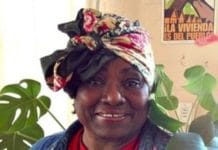by Lynda Carson
Oakland – On July 16, Public Advocates, a nonprofit law firm, sent out a press release announcing that, bowing to community pressure, Oakland has invited new proposals for affordable housing at the controversial Lake Merritt East 12th Street parcel that local groups protested against as an illegal land deal with Urban Core that violated the Surplus Land Act governing the sale of publicly owned land.

“We are very excited about the city’s decision to comply with the law and address community concerns by re-opening the process,” said Monica Garcia, who lives just two blocks from the site and is a member of Eastlake United for Justice, a neighborhood group advocating for affordable housing in Oakland. “As we move forward, we urge the city to work with the community to ensure that affordable housing is built on the East 12th parcel and remain true to the idea that public land should be used for the public good,” she said.
Now that the land deal that would have illegally benefited Urban Core has been scuttled by city officials and the parcel is now up for bid as a possible site for so-called affordable housing, the question arises as to what kind of so-called affordable housing site will it eventually become?
Many are already asking, are the so-called affordable housing projects in Oakland and the Bay Area really affordable to most disabled persons receiving their income through SSI, or are they affordable for retired persons receiving Social Security? Apparently they are not.
As an example, during 2014 at the Avalon senior housing project located at 3850 San Pablo in Oakland, the East Bay Asian Local Development Corp. (EBALDC) demanded that people seeking housing at this subsidized project must have a minimum income of at least twice the rent. During 2014, studio apartments were going for $600 a month at this project, one bedroom apartments were as high as $712 per month, and two bedroom apartments were $845. Many low-income disabled and retired persons on Social Security could not afford to reside there due to the minimum income requirements.
During 2014, the average monthly Social Security check for a single retired worker was $1,294, which means that the average retired person on Social Security cannot afford to reside in a one-bedroom or two-bedroom apartment at the Avalon senior housing project and can barely afford to reside in a studio apartment at this location. Many retired and disabled workers earn much less than $1,294 per month as Social Security income or SSI, and as a result the retired and disabled persons face discrimination at many so-called affordable housing projects in Oakland and throughout the Bay Area.
Many are already asking, are the so-called affordable housing projects in Oakland and the Bay Area really affordable to most disabled persons receiving their income through SSI, or are they affordable for retired persons receiving Social Security? Apparently they are not.
The average Social Security monthly benefit in California during 2014 was $1,294 per month. The average SSI (disability) benefit payment was $877.40 per month. The average TANF (CalWorks) family in California is an adult with two children that receives $510 a month in benefits. General Assistance in California during 2014 pays $336 per month to a single person. Food Stamps (CalFresh/SNAP) for one person is $189 per month, and persons receiving SSI or SSP are not allowed in the program.
During 2013 the average monthly food stamp benefit for one individual in California was $151.44. Additional records reveal that during 2011, in California’s 13th Congressional District, Congresswoman Barbara Lee’s district, 11,899 households received food stamps, including 16 percent of households with one or more people 60 years or older and 76.8 percent of households with children under 18. Around 46.6 percent of the households’ income was below the poverty level, with the median income around $27,441.
When taking a closer look at many so-called affordable housing projects in Oakland and the Bay Area, it appears that unless the disabled persons receiving SSI and many persons retired on Social Security have Section 8 housing vouchers (Housing Choice Vouchers), most of them do not have an income high enough to reside in many so-called affordable housing projects.
Ironhorse, a so-called affordable housing project at Central Station in Oakland
As another example of a project with minimum income requirements that discriminate against the poor and disabled, we can look at the Ironhorse so-called affordable housing project at Central Station, a 99-unit project developed by Bridge Housing. The project is funded in part by a federally regulated government program called the Low Income Housing Tax Credit Program (LIHTC), as well as other sources of funding to subsidize the housing project, according to Bridge Housing.
During 2010, Bridge Housing announced that the Ironhorse so-called affordable housing project delivers 99 apartments for families earning up to 50 percent of the local area medium income (AMI), or let’s just say that most persons at Ironhorse are required to have incomes between $18,000 and $50,000 annually. Out of 99 apartments, there are 20 at Ironhorse set aside for those with the lowest incomes residing in units receiving rent subsidies from the federal government through Oakland Housing Authority.
As another example of a project with minimum income requirements that discriminate against the poor and disabled, we can look at the Ironhorse so-called affordable housing project at Central Station, a 99-unit project developed by Bridge Housing.
Ironhorse demands that the income of a person seeking to rent a one bedroom apartment for $460 per month must earn between $15,771 and $19,650 per year to reside in what is called Tier 1. The minimum income requirement is way more than the average retired person on Social Security or a disabled person on SSI earns and leaves them out in the cold unless they have a Section 8 voucher.
In Tier 2 at Ironhorse, a person renting a one-bedroom apartment that rents for $541 per month must have an income between $18,549 and $22,925 per year. In Tier 3, Bridge Housing demands that a person renting a one-bedroom apartment for $622 per month must have an income between $21,326 – $26,200. There are no minimum income requirements for Section 8 applicants (Housing Choice Voucher applicants), according to their application documents.
The harsh reality at this so-called affordable housing project subsidized by taxpayers is that most low-income disabled and retired people face discrimination due to the minimum income requirements imposed by Bridge Housing, a $2 billion so-called nonprofit housing developer.
Other properties with minimum income requirements discriminating against the poor during 2014
At the Erna P. Harris Court in Berkeley, owned by Resources for Community Development (RCD), they are demanding that tenants earn a minimum of $5,700 per year to be able to reside in an SRO unit, and must earn at least $9,495 per year to reside in a one-bedroom apartment at this taxpayer subsidized so-called affordable housing project.
Residents at the Fargo Senior Center in San Leandro, owned by Christian Church Homes of Northern California (CCH), are required to earn as much as twice the rent at this so-called affordable housing project. Studio apartments go for as much as $491-$818 per month, and one-bedroom apartments cost $526-$876 per month, leaving many poor Social Security recipients out in the cold because they do not meet the minimum income requirements at this taxpayer subsidized housing project.
At the Fremont Oak Gardens, owned by SAHA Homes, another so-called affordable housing developer, poor people face discrimination if they fail to meet the minimum income requirement of $10,994 per year for seniors 55 and older.
The Harrison Hotel in downtown Oakland, which has 81 SRO units in the building, requires that poor people earn as much as twice the rent, and the rent at this location is $375 per month.
Helios Corner, owned by SAHA Homes in Berkeley, has 80 senior and special needs units but demands that poor people must earn $17,304 per year to reside in a studio apartment, $18,456 for a one-bedroom unit and a whopping $22,080 for a two-bedroom unit in this so-called affordable taxpayer subsidized housing project.
The project called Homes Now in the Community, owned by SAHA Homes in Oakland, has 10 special needs apartments for rent but demands that the low-income tenants in the area must earn as much as 30 percent of the local AMI (area median income) to reside there.
Merritt Crossing Senior Apartments in Oakland, which is also owned by SAHA Homes, is a 70-unit project for seniors. Poor people face discrimination at this so-called affordable housing taxpayer subsidized project if they do not earn as much as $11,328 per year to live in a studio apartment or $18,408 per year for a one-bedroom apartment.
Northgate Terrace for seniors in Oakland, owned by Christian Church Homes of Northern California (CCH), requires that the poor elderly people seeking housing at this taxpayer subsidized housing project must earn as much as $1,450 per month, which is way more than the average person receiving Social Security earns each month.
The Peter Babcock House in Berkeley, owned by SAHA Homes, is a special needs project with five SRO units and demands that poor people must earn at least $7,320 per year to reside in this taxpayer subsidized so-called affordable housing project.
At the Ellis Street Apartments in San Francisco, owned by Asian Inc., another so-called affordable housing developer, is a project with 30 units of studio and one-bedroom apartments, and the minimum income requirement is $1,400 per month, which discriminates against the average person receiving Social Security payments of $1,294 per month.
The Bayanihan House in San Francisco, owned by TODCO, has 152 SRO units with shared bathrooms and charges $545 per month in rent, but they have a minimum income requirement of $866.40 per month, which leaves many out in the cold.
Coleridge Park Homes for seniors in San Francisco, owned by Bridge Housing, has a minimum income requirement of $17,616 per year for some and as much as $26,808 per year for others at this taxpayer subsidized housing project.
The Knox SRO building in San Francisco, owned by TODCO, has 18 SRO units, and they have a minimum income requirement of $866.40 at this taxpayer subsidized so-called affordable housing project.
The William Penn Hotel in San Francisco, owned by Chinatown Community Development Corp., has 96 SRO units, and the minimum income requirement is 1.5 times the rent. The rent is $460-$541 per month at this taxpayer subsidized so-called affordable housing project, leaving many poor people out in the cold.
Lynda Carson may be reached at tenantsrule@yahoo.com.

 Store
Store






